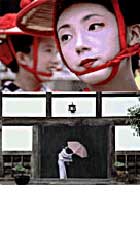
The Fourth Dimension 2001
Distributed by Women Make Movies, 462 Broadway, New York, NY 10013; 212-925-0606
Produced by Jean-Paul Bourdier and Trinh T. Minh-ha
Directed by Trinh T. Minh-ha
VHS, color, 87 min.
Adult
Asian Studies, Dance, Drama, Film Studies, Gender Studies, Poetry, Travel and Tourism
Date Entered: 11/09/2018
Reviewed by Jo Manning, Barry University, Miami Shores, FLExperimental video… How to judge it? This is a gorgeous videotape, 1 ½ hours of pretty images and intriguing sound, but the ponderous narration weighs down the gossamer quality of Trinh Minh-ha’s direction. Is it a documentary, a travelogue of modern Japan, an exploration of centuries-old rituals (dance/drama/festivals/etc.), does it give insights into Japanese society and culture? Is it political? It’s a little of this and a little of that, including bits of home video, a mix that’s sometimes genuinely poetic but generally frustrating. What are the rituals (many involving complicated drumming sequences) taking place on the screen? What do they mean? Where are they taking place? Such lovely countryside, but just where is it? A speeding bullet-train seems to serve as a metaphor for the too-fast passing of time, the fourth dimension. Or does it? The narrative meanders, anchored briefly by quotes from haiku poets, philosophers, Noh drama, and contemporary events, a veritable pastiche of Japanese iconography.
Vietnam-born Minh-ha, a Women’s Studies and Film professor at the University of California at Berkeley, the narrator as well as the director/co-producer/editor/still photographer, has a light, well-modulated, pleasing voice that provides no enlightenment for the viewer. What is she trying to say? It’s puzzling. This is an ephemeral piece, amazingly ephemeral for all of its length, loosely organized and more pretty wallpaper and nice music (it actually has a terrific musical score by The Construction of Ruins, with Greg Goodman and Shoko Hikage) than the meaningful social, artistic, or philosophical commentary/documentary to which it seems to aspire. One hesitates to say pretentious, or boring, because one has to appreciate the serious photography (beautifully framed images---the shimmering dew on a deep green lotus leaf, the timbered old doorway leading out to a formal garden, the geometrically-sculpted fields of rice and vegetables under the bluest skies….) and editing (some truly lovely examples of experimental visual technique that take one's breath away) that do deserve respect, but it's recommended with reservations, because it's clearly not for everyone and is much, much too long and repetitive. The average adult viewer will quickly tire of The Fourth Dimension, despite its splendid images, but it's recommended for those involved and/or interested in experimental video, and there's peripheral value for those interested in Japan and Japanese culture---such as libraries in areas with substantial numbers of Japanese-Americans and other Asian groups---but is it an essential purchase for most public libraries? Because of its limited audience appeal, probably not.